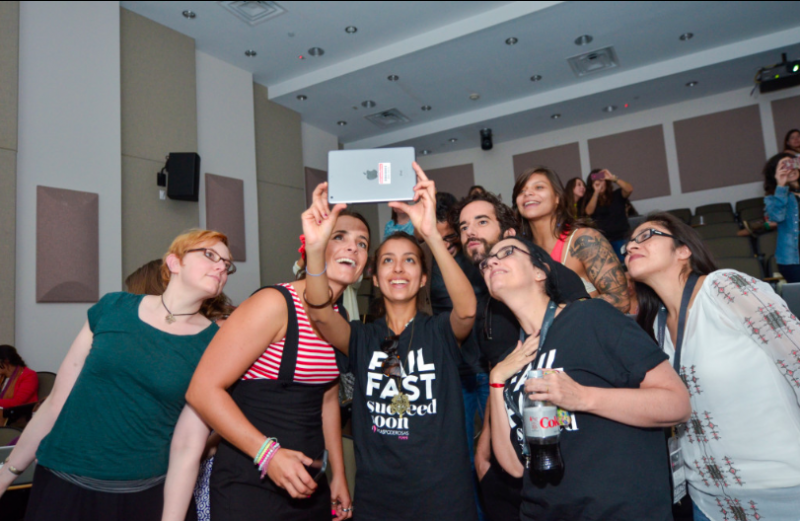
Chicas Poderosas Conference in Miami, Florida. Photo: Chicas Poderosas.
“If you educate a man you educate an individual, but if you educate a woman you educate a family (nation)”.
The African proverb above has help guide the work of Mariana Santos, the founder of Chicas Poderosas, a group trying to increase the number of Hispanic-American women working directly with newsroom technology. Santos knows what challenges women face in this male-dominated industry. Even in the digital age, women journalists in Latin America work at a systematic disadvantage.
Santos is a Portuguese visual designer who's worked for The Guardian, and is currently the director of “interactive and animation” at Fusion. She says digital-media training is still limited and there are still too few programs focused on women, which keeps them underrepresented in the world of technology journalism.
In 2013, thanks to a fellowship at the International Center for Journalists (ICFJ) [1], Santos created Chicas Poderosas to help change things in the industry. Staging events and meet-ups, and offering mentoring, Chicas helps women develop news applications, produce interactive content, and integrate new tools into their newsrooms, according to the group's website [2].
The most recent Chicas Poderosas conference was held at Stanford University last June, where 35 women journalists and developers from Latin America met for roughly four days. Santos summarized [3] the event as “all the best experiences, classes, [and] people I met during my nine months as a JSK fellow [4].”
Now this is a powerful group of @poderosaschicas [5] here at @google [6]! #journalism [7] #media [8] pic.twitter.com/273dmFZfNu [9]
— Stacie Chan (@staciechan) June 10, 2015 [10]
The ultimate goal of the Summit and of Santos’ Chicas Poderosas movement is to help women take the lead in newsroom technology and design as a way to bring women's voices into both newsrooms and the content newsrooms generate.
After the Stanford event, Dow Jones [12]was the first to create Chicas Poderosas fellowships—sending two Latin American women journalists to newsrooms specialized in digital storytelling.
We are very happy to announce the first fellowship Dow Jones-Chicas Poderosas http://t.co/5rxThRdYvm [13] Tks!!! @raju [14] #CPdowjones [15] #ChicasFellow [16]
— Chicas Poderosas (@poderosaschicas) July 10, 2015 [17]
Maria Paula Martinez, from Colombia’s Universidad de Los Andes went to NPR [18]. She expressed her enthusiasm on Twitter:
Chicas Poderosas | #ChicasFellow [16] 2015 -NPR dream come true ¡Mi beca en NPR! un sueño hecho realidad http://t.co/OMbjfckWRh [19] @poderosaschicas [5]
— Chicas Poderosas (@poderosaschicas) July 13, 2015 [20]
And Mariana Barbosa, a former La Nacion Argentina student and journalist, went to ProPublica [21], an independent, non-profit newsroom that produces investigative journalism in the public interest:
“Hello @ProPublica [22] ” the new post by @marianabarbosa [23] about the #CPdowjonesfellow [24] Click here: http://t.co/VnqdVvp0wN [25] — Chicas Poderosas (@poderosaschicas) July 14, 2015 [26]
For more information about how to get involved in Chica Poderosa, visit its website [27].